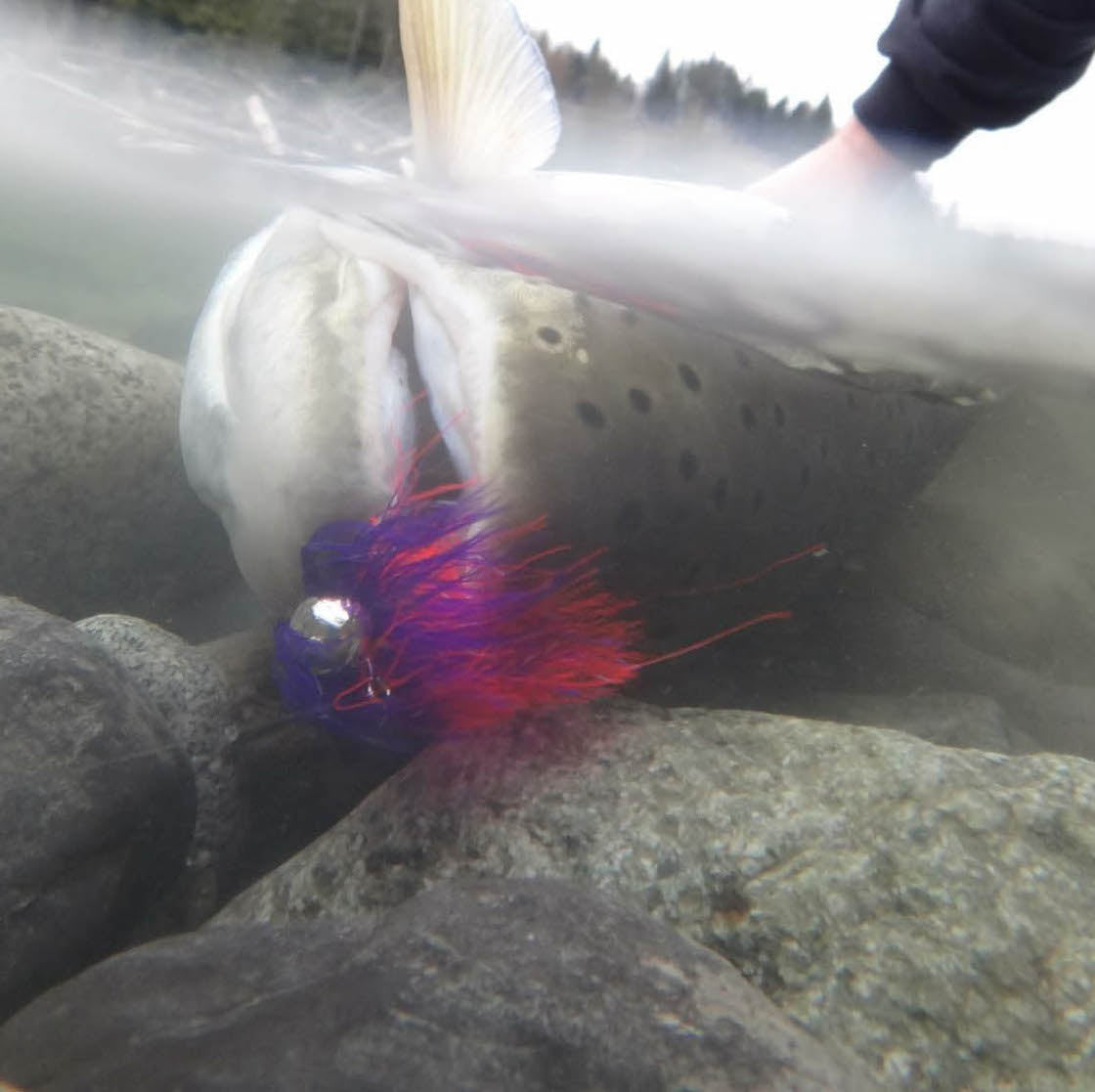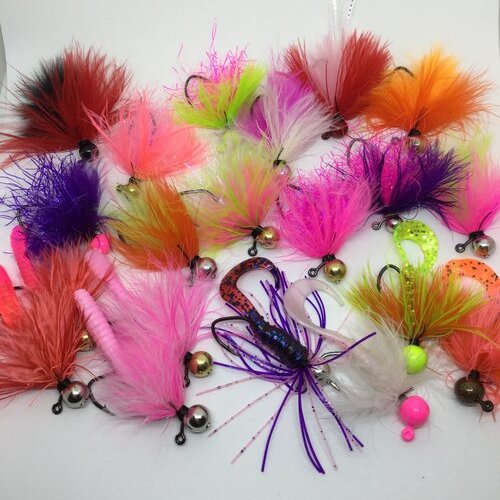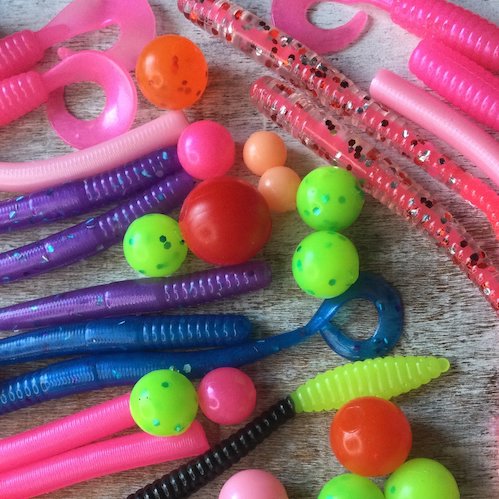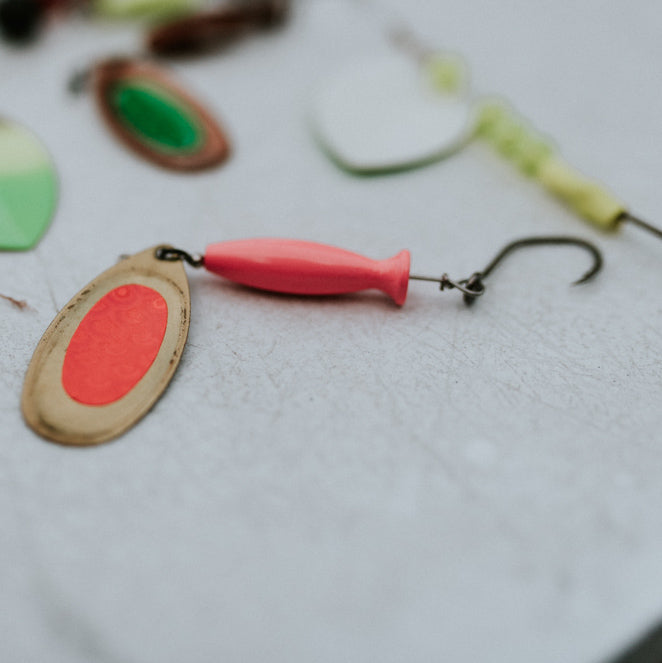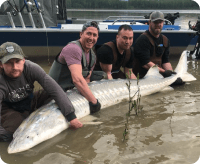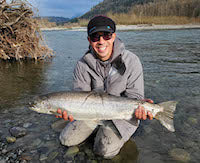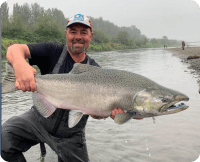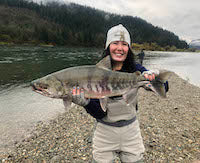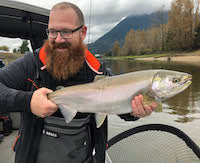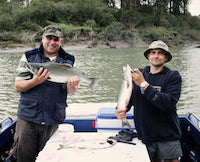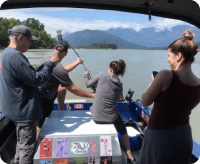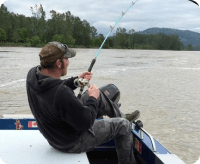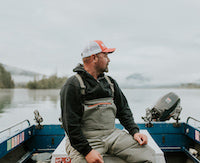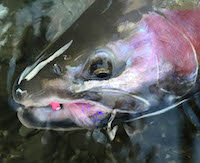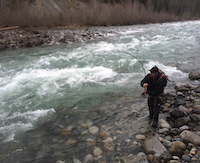Just some quick info here to get you on your way to a successful day of sight fishing for salmon or steelhead in your favorite river or creek.
First off, of utmost importance is wearing dark camouflage clothing. Browns, olive, dark grey and even full camo is necessary under most spot and stalk conditions. Dark clothing will help you blend into the back ground and not alarm wary fish in the low water conditions. Blue, red and white are definite no-nos that will spook fish, even when an otherwise stealthy approach is used. Yellow rain coats are not allowed!
Spotting the fish is a talent that comes from much practice. Good polarized glasses are a must. They cut the surface glare of the water and allow an unobstructed view of the river bottom and all that it holds. Choppy runs are hard to spot fish in but by carefully scanning the flow and following the small slicks that go through every piece of holding water the fish can be spotted. If at all possible, getting a vantage point above the suspected holding water is definitely preferable to being at water level. The decreased angle of vision allows for easier penetration of the waters surface and a more accurate placement of any spotted fish in the run or pool. Many times on sunny days you won’t see the fish first but instead you will see its shadow. Be aware and pay close attention to anything that seems out of place. If you are looking primarily at a pea gravel bottom stretch of river and you see what appears to be a larger rock or small log, look closely and make sure before passing it up. A good indicator is to find a small differently colored stone immediately in front of or behind the suspect and watch for movement. Many times what appears to be a fish is only an oblong rock that appears to be moving because of the surface slicks of the water, but not always. If in doubt, sneak up and make a few casts just to make sure. Be aware that if you spot one fish there may be more! I have been burned on more than one occasion when I spotted a fish and moved into casting position only to spook a fish that I didn’t see which in turn spooked the target fish. Many times I will spend from 5 to 10 minutes scanning the water just looking for fish before moving in to make a cast.
Be sneaky when approaching a drift either to fish or try and spot fish. Step lightly and if at all possible, from behind. Steelhead and salmon have very good vision and can see you from almost any direction that you approach, including down stream but light refraction and possible ripples on the waters surface make the down stream approach the most effective under these demanding conditions. When fish are located close to the bank, I will literally crawl to within casting distance to make sure that the fish are unaware of my presence. It looks silly and may seem a little over dramatic but the effort is usually worth it. Also, be very careful not to stomp around or roll rocks/logs under your feet when nearing the fish. The vibrations carry through the ground and directly to the fish’s sensitive lateral line alerting them that something is amiss. If it is necessary to move in from in front of the fish I will lay down and crawl on my belly into casting position being careful not to rise up any more than necessary to keep my eye on the quarry.
We have already gone over approaching the fish so now we will deal with presentation. I find light line to be the most effective in these unlimited visibility conditions. Usually 6 or 8 pound line on a limber rod is perfect for fooling these fish. If there are heavy rapids or when targeting large fish, I will go up to 10 lb line. My preferred set up for these conditions is a light action 13' rod with a ball bearing centerpin reel spooled with low diameter 12 lb line. For terminal tackle I like to use half a wine cork with a hole drilled in it and held in place with a tooth pick. I will then tie on a small1/16 oz dark colored jig, black/pink is nice, or a size 6 to 2 hook on a 6lb leader and add either no weight or a small split shot 2' or 3' above the hook. If fishing heavier water, use only enough weight to get down to the fish. Less is definitely more effective in these circumstances. When using bait, I like a tiny piece of natural coloured roe or a tiny piece of shrimp with a small piece of light pink yarn in the bait loop. In artificial only waters, its hard to beat small glow bugs or a small dark coloured jig.
Now for the easy part- the actual presentation of the bait. Once you are in position and out of view from the fish, cast your offering as far up stream as you can while maintaining control of your gear. Usually 20' or so ahead of the fish will be adequate. You want to make sure that you are getting the most natural drift possible at all times. Try not to wave your arms all over the place when casting by using a side arm motion and keeping your arm and rod parallel to the ground to minimize the impact of the cast. The worst case scenario is your gear landing directly on top of the fish which will surely spook it. In cases where my cast has gone terribly wrong I will either let it fly far over the target and make a better cast on the next try or stop the cast short and let it fall on the ground instead of in the water. After going through all the effort of spotting and then sneaking up on the fish I would rather re-tie my terminal gear on a near shore break off and pick it up after I have hooked the fish than spook it right off the bat. Most times under these conditions you can watch the fish take your offering. What a thrill! Most takes will be subtle and the urge is to set the hook too soon. Fight the urge and wait for the float to submerge or to see the fish finish closing its mouth on your bait.
Once the fish is hooked, take your time and don’t try to horse them in on the light line. Small hooks pull out easily and light line is fragile and weakens much faster than heavier ones.
It might seem like a lot of work just to hook a fish but the sense of satisfaction from hunting and stalking the fish will far out weigh any of the challenges and hardships involved and you will come to relish the times of low water when others are complaining about skittish fish and difficult conditions.
First off, of utmost importance is wearing dark camouflage clothing. Browns, olive, dark grey and even full camo is necessary under most spot and stalk conditions. Dark clothing will help you blend into the back ground and not alarm wary fish in the low water conditions. Blue, red and white are definite no-nos that will spook fish, even when an otherwise stealthy approach is used. Yellow rain coats are not allowed!
Spotting the fish is a talent that comes from much practice. Good polarized glasses are a must. They cut the surface glare of the water and allow an unobstructed view of the river bottom and all that it holds. Choppy runs are hard to spot fish in but by carefully scanning the flow and following the small slicks that go through every piece of holding water the fish can be spotted. If at all possible, getting a vantage point above the suspected holding water is definitely preferable to being at water level. The decreased angle of vision allows for easier penetration of the waters surface and a more accurate placement of any spotted fish in the run or pool. Many times on sunny days you won’t see the fish first but instead you will see its shadow. Be aware and pay close attention to anything that seems out of place. If you are looking primarily at a pea gravel bottom stretch of river and you see what appears to be a larger rock or small log, look closely and make sure before passing it up. A good indicator is to find a small differently colored stone immediately in front of or behind the suspect and watch for movement. Many times what appears to be a fish is only an oblong rock that appears to be moving because of the surface slicks of the water, but not always. If in doubt, sneak up and make a few casts just to make sure. Be aware that if you spot one fish there may be more! I have been burned on more than one occasion when I spotted a fish and moved into casting position only to spook a fish that I didn’t see which in turn spooked the target fish. Many times I will spend from 5 to 10 minutes scanning the water just looking for fish before moving in to make a cast.
Be sneaky when approaching a drift either to fish or try and spot fish. Step lightly and if at all possible, from behind. Steelhead and salmon have very good vision and can see you from almost any direction that you approach, including down stream but light refraction and possible ripples on the waters surface make the down stream approach the most effective under these demanding conditions. When fish are located close to the bank, I will literally crawl to within casting distance to make sure that the fish are unaware of my presence. It looks silly and may seem a little over dramatic but the effort is usually worth it. Also, be very careful not to stomp around or roll rocks/logs under your feet when nearing the fish. The vibrations carry through the ground and directly to the fish’s sensitive lateral line alerting them that something is amiss. If it is necessary to move in from in front of the fish I will lay down and crawl on my belly into casting position being careful not to rise up any more than necessary to keep my eye on the quarry.
We have already gone over approaching the fish so now we will deal with presentation. I find light line to be the most effective in these unlimited visibility conditions. Usually 6 or 8 pound line on a limber rod is perfect for fooling these fish. If there are heavy rapids or when targeting large fish, I will go up to 10 lb line. My preferred set up for these conditions is a light action 13' rod with a ball bearing centerpin reel spooled with low diameter 12 lb line. For terminal tackle I like to use half a wine cork with a hole drilled in it and held in place with a tooth pick. I will then tie on a small1/16 oz dark colored jig, black/pink is nice, or a size 6 to 2 hook on a 6lb leader and add either no weight or a small split shot 2' or 3' above the hook. If fishing heavier water, use only enough weight to get down to the fish. Less is definitely more effective in these circumstances. When using bait, I like a tiny piece of natural coloured roe or a tiny piece of shrimp with a small piece of light pink yarn in the bait loop. In artificial only waters, its hard to beat small glow bugs or a small dark coloured jig.
Now for the easy part- the actual presentation of the bait. Once you are in position and out of view from the fish, cast your offering as far up stream as you can while maintaining control of your gear. Usually 20' or so ahead of the fish will be adequate. You want to make sure that you are getting the most natural drift possible at all times. Try not to wave your arms all over the place when casting by using a side arm motion and keeping your arm and rod parallel to the ground to minimize the impact of the cast. The worst case scenario is your gear landing directly on top of the fish which will surely spook it. In cases where my cast has gone terribly wrong I will either let it fly far over the target and make a better cast on the next try or stop the cast short and let it fall on the ground instead of in the water. After going through all the effort of spotting and then sneaking up on the fish I would rather re-tie my terminal gear on a near shore break off and pick it up after I have hooked the fish than spook it right off the bat. Most times under these conditions you can watch the fish take your offering. What a thrill! Most takes will be subtle and the urge is to set the hook too soon. Fight the urge and wait for the float to submerge or to see the fish finish closing its mouth on your bait.
Once the fish is hooked, take your time and don’t try to horse them in on the light line. Small hooks pull out easily and light line is fragile and weakens much faster than heavier ones.
It might seem like a lot of work just to hook a fish but the sense of satisfaction from hunting and stalking the fish will far out weigh any of the challenges and hardships involved and you will come to relish the times of low water when others are complaining about skittish fish and difficult conditions.



